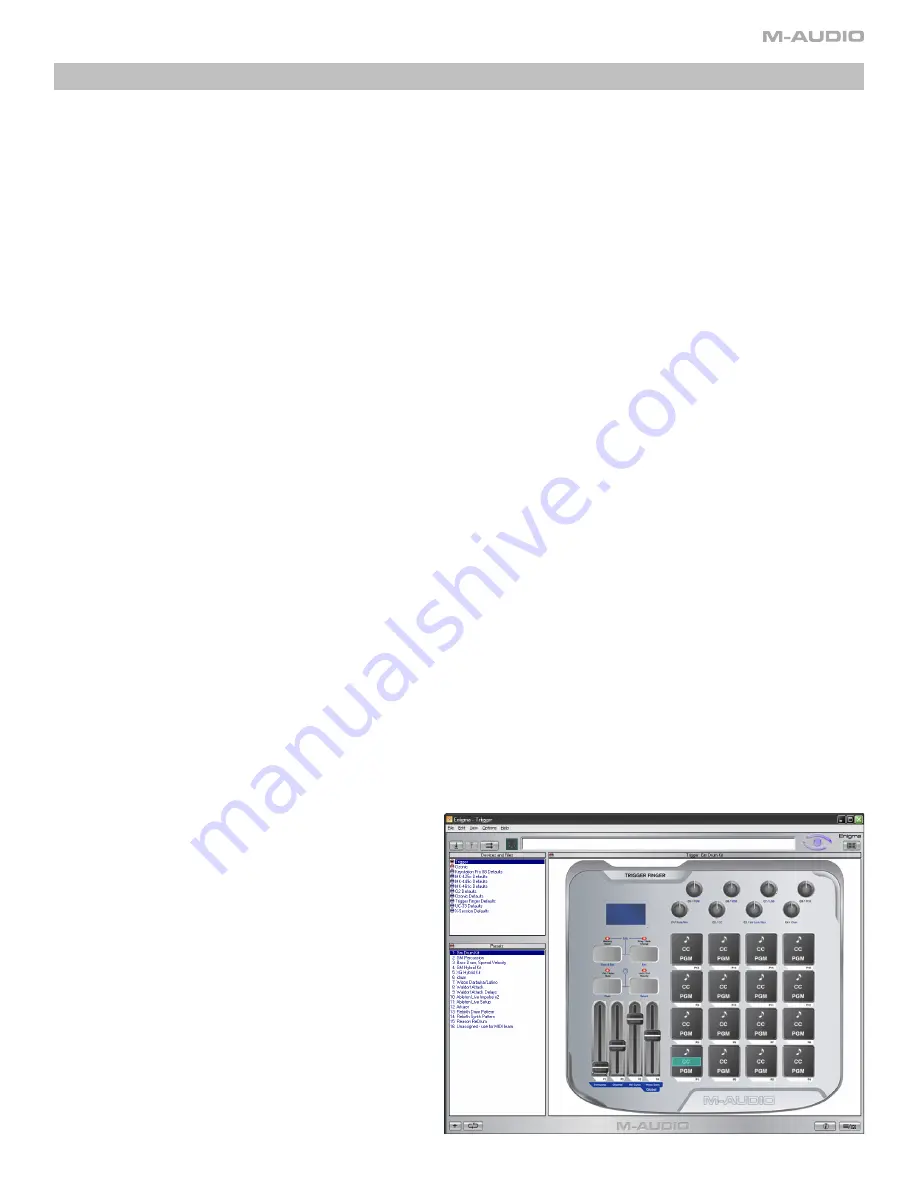
10
Enigma Software
The Enigma Editing software makes creating, editing, and storing memory setups for the Trigger Finger a snap. Its simple, drag-and-drop interface streamlines the
re-programming process, and it also gives access to a few extra features. Additionally, memory setups can be stored on the computer, thus allowing you to amass
a collection of more than 16 memory setups.
Installing Enigma
Enigma is located on the supplied MIDI Controller CD-ROM. This is the most current version at the time of pressing. We still recommend, however, that you check the
M-Audio website (www.m-audio.com) for the latest version of the program as there may have been updates since the CD-ROM was originally made.
Windows Users:
1. Run the file ‘enigma_pc.exe’.
2. Follow the onscreen instructions.
Mac OS X Users:
1. Double-click on the file ‘enigma_mac.dmg’.
2. Drag ‘Enigma’ to the location on your hard drive where you want to install the software (we recommend placing Enigma in your Applications folder).
Navigating Enigma
As long as the Trigger Finger is connected to your computer and correctly installed, Enigma will recognize your Trigger Finger on start up. You will see the Trigger
Finger listed in the bank list (the window in the top left hand corner) with a red symbol next to it. If this is not the case, please consult the troubleshooting section.
The Device List
Enigma is an editor and librarian that has been developed to support the entire range of programmable products from M-Audio. As a result, you will see a number
of other M-Audio and Evolution controllers listed in the bank window. These are provided to let you swap presets between different controllers. For example, if you
wanted to set up a control for Reason’s Subtractor synth, you could copy the controls directly from the UC-33e’s Reason Subtractor preset to the controls of your
Trigger Finger.
As well as the red device (your connected Trigger Finger controller), other devices in the device list are represented with blue symbols (blue devices) and orange
symbols (orange devices). Blue devices represent the factory presets of the various controllers. If you send the blue ‘Trigger Finger defaults’ file to your Trigger Finger,
it has the effect of performing a factory reset. Orange devices are your own user-created devices. You can create as many of these as you like simply by clicking on
the ‘+’ button in the bottom left hand corner.
The Preset List
The Preset List is positioned directly underneath the device window. Click on the red device in the list. This device represents the physical memory on your Trigger
Finger unit. You will see that all the presets of the Trigger Finger are listed with their factory default names. Note that although you can name presets anything you
like, the Trigger Finger itself does not store these names. The naming of presets is an Enigma function only. If you click on other devices in the device list, you will
see that the preset list updates accordingly.
Data Display
The main area in the Enigma software is reserved for displaying the data contained in the preset you have currently selected in the Preset List. Normally, you will see
a graphical representation of the controller that is selected in the Device List. The View Select button in the bottom right-hand corner enables you to switch between
the Graphic View and a more detailed List View. The List View is useful as a quick reference for the entire contents of the preset.
Click on the red device in the device list to select the Trigger Finger. Click on the View Select button to select the Graphic view. You will now see your Trigger Finger
represented in Enigma. Now double-click on one of the controllers. This brings up the ‘Editor’ dialog. In the editor dialog you are able to change the assigned
parameters for the controller you have selected.
Communication Between the Trigger Finger and Enigma
Enigma communicates with your Trigger Finger controller using the three
buttons above the Device List. If you move the mouse over each of these
three buttons, you will see a tool tip which describes the function of each
button. From left to right, the buttons are:
• Receive:
This button will update the red device in the Device List with
the current contents of your Trigger Finger’s memory. Note that it is
always the red device that is updated, regardless of the bank you
have selected currently.
• Update:
This button sends only the edits in the red device to your
Trigger Finger controller. As such, it is a quicker data transfer.
• Send:
This button will send the currently selected bank to your
Trigger Finger device.























